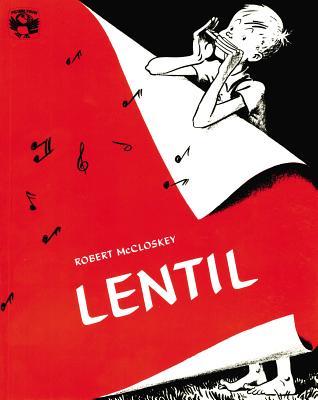Recently, we read "Lentil". In the book, the vocally challenged Lentil finds his mantra through the harmonica and ends up saving the day with it. That is a very brief synopsis, but the book actually had so many different interesting and fun pieces to it. A quick search on pinterest and several other sites (including homeschoolshare.org) gave me a plethora of ideas for activities to complete with the kids while we rowed the book. We have actually even extended our "rowing" beyond the five days, because we have enjoyed this book so much.
On the first day, I got out my harmonica for the kids to try out. This was a huge hit! The kids loved it, which excited me since I have a huge love for music and musical instruments. My plan was to take them to a music store and let them try out various instruments to see if there was anything they would have an interest in playing (whether now or in the future). In the book, Lentil plays the harmonic in the bathtub, because it improved the tone 100% (discussion of the 100% was a great opportunity to do activities that taught the kids about percentage). Abbey decided to try out the harmonica in the bathtub, to see if the tone really was significantly improved.
Then, we made that trip to the music store. The employees measured Abbey and Luke's arm lengths to see which violin would be appropriate for them to try out. The violin for Abbey was the tiniest one they make, and looked like it was a toy for a baby doll. It was adorable. And then they showed Abbey how to hold it. Oh. My. Goodness. It was the most precious thing ever. All of the employees in the store were saying with a "how sweet" tone in their voices, "Awwwwwww" when they saw her holding the tiny violin. And honestly, the violin didn't look tiny when she held it. It looked just her size. I guess the measuring thing is done for a reason--ha! Here is a video of her playing the little violin. They didn't have any used bows that they would let her use, so she just used her fingers to pluck the strings.
We didn't buy a violin while we were there--that thing was $400! But, I did look for used ones on craigslist when I returned home and found I could probably pick one up for a quarter of that cost! Now, I will just wait to see if Abbey shows more interest in learning and can take care of one appropriately. Although we didn't purchase any musical instruments, I did pick up a beginning Alfred's basic piano book, so I can give Luke piano lessons. These are the same books I learned on when I was a child. I was going to seek out a private teacher to give Luke piano lessons, but then I figured, why pay someone else to teach him when I can do so for free. So, that is what we are doing. I feel strongly that music is vital to their education. So many studies have shown the numerous values of a musical education and playing musical instruments--including studies which show its value in math. The link between the physical practice of music and strong mathematical abilities are demonstrated in studies that show that kids who play a musical instrument can perform more complex arithmetical operations than those who do not play an instrument. The constant practice, the attention to detail and the discipline it takes to learn an instrument are also excellent preparation for the practice involved in building strong math skills.
Art was another fun subject we got to tackle with our reading of "Lentil." The artwork in the book is very cool and was completely created by using charcoal. So, we had some fun experimenting using charcoal. We also learned about charcoal's earliest uses in cave art (believed to be created using burnt sticks) and how its made.
In the book, a grumpy older character, "Old Sneep" is usually seen sitting on a park bench whittling. So, the next day, we practiced "whittling" with some soap. I purchased some cheap soap for Luke, Abbey and I to practice on.
We began by drawing on the soap the outline of what we wished to whittle.
 |
| Abbey chose the flower. |
 |
| Luke chose the fish, and I chose the penguin. As you can see on this picture, Abbey and I were not as successful as Luke--ha! |
 |
| He was the only one successful at the task at hand. |
 |
| Patience pays, folks. |
 |
| From left to right: penguin (with sad wings which fell off but I pressed back on), flower, and fish. |
We also plugged our noses and tasted different foods to see if it made a difference in how it tasted.
 |
| Luke tasting sweet applesauce with his nose plugged. |
 |
| Abbey tasting a sour lemon. |
We had a blast with Lentil (and still are), so we are renewing this library book!





No comments:
Post a Comment